#milky way galaxy
Explore tagged Tumblr posts
Text

The Aurora Australis seen from New Zealand // max.nti
#astronomy#astrophotography#night sky#earth's atmosphere#aurora#aurora australis#galaxy#spiral galaxy#milky way#milky way galaxy#our galaxy#our home#landscape#beautiful#peaceful#new zealand
174 notes
·
View notes
Text
Milky Way Center Wide Field Mosaic 135mm


#milky way#milky way galaxy#galaxies#galaxy#astronomy#astronomers#universe#astrophotography#nasa#nasa photos#astrophysics#outer space#nasawebb#hubble space telescope#nasa science#science facts#planetary science#nasa picture of the day#nasa jpl#nasaastronaut#nasa cassi#space science#science#international space station#space exploration#space#space travel#space photography#the universe#cosmos
191 notes
·
View notes
Text

Sagittarius and the Central Milky Way - June 5th, 1996.
"What does the center of our Milky Way galaxy look like? It is not possible to see the galactic center in light our eyes are sensitive to, because the thick dust in the plane of our galaxy obscures it. If one looks in the direction of our galaxy's center - which is toward the constellation of Sagittarius - many beautiful wonders become apparent, though. The center of the Milky Way is behind the center of the photo. Large dust lanes and star clouds dominate the picture. As many as 30 Messier objects are visible, including all types of nebula and star clusters. Two notable nebula include the Lagoon Nebula (M8), a small red patch just above the center, and slightly above this is the red and blue Trifid Nebula (M20). The lines through the picture were caused by airplanes, and the dark objects in the foreground are trees."
#nasa#space#cosmos#universe#astronomy#astrophysics#astrophotography#sagittarius constellation#milky way galaxy#lagoon nebula#trifid nebula
116 notes
·
View notes
Text

If you ever get lost in the Milky Way galaxy, this is your map to get back to EARTH. 🌌🔍🌍
By: @budassiuniverse via X
60 notes
·
View notes
Text

"Perseids over the Bohemian Forest" 🌌 Counted over 70 meteors painting the night sky in one hour!
📸 Thomas Havel Photography
The composite image was taken from Březník on the northern edge of the Luzenské valley in Šumava National Park. The whole location is in the middle of wild forests and is one of the darkest places in the Czech Republic. The night sky includes the central arch of our Milky Way Galaxy and the planets Saturn and Jupiter on the left side of the Milky Way. Make a wish! 💫
#Thomas Havel Photography#Perseids#Meteors#Night Sky#Czech Republic#Milky Way Galaxy#Saturn#Jupiter#Amazing#Nature#Travel
325 notes
·
View notes
Text





Jan Oort – Scientist of the Day
Jan Oort, a Dutch astronomer, died on Nov. 5, 1992, at the age of 92, having been born in the last year of the 19th century, Apr. 28, 1900.
read more...
#Jan Oort#cosmology#Milky Way galaxy#comets#histsci#histSTM#20th century#history of science#Ashworth#Scientist of the Day
26 notes
·
View notes
Text

milky way galaxy ❣️💛❤️ via Physics Is Fun
#milky way galaxy#milky way#astronomy#universe#space#outer space#cosmos#galaxy#gods creation#beauty#spectacular#Physics Is Fun
23 notes
·
View notes
Text

Feynman: When we were talking about the atoms, one of the troubles that people have with the atoms is that they're so tiny, and it's so hard to imagine the scale.
The size of the atoms are in size - compared to an apple, it's the same scale as an apple is to the size of the Earth. And that's a kind of a hard thing to take, and you have to go through all these things all the time, and people find these numbers inconceivable. And I do too.
The only thing you do is you just change your scale. I mean, you're just thinking of small balls, but you don't try to think of exactly how small they are too often! Or you'd get kind of a bit nutty, alright?
But in astronomy, you have the same thing in reverse because the distances to these stars is so enormous, you see. You know that light goes so fast that it only takes a few seconds to go to the moon and back, or it goes around the Earth seven-and-a-half times in a second. And goes for a year, two years, three years before it gets to the nearest other star that there is to us.
But all of our stars are... the stars that are nearby in a great galaxy, a big mass of stars, which is called a galaxy, a group, well this, our galaxy is... what is it? Something like a hundred thousand light years, a hundred thousand years.
And then there's another patch of stars. It takes a million years for the light to get here, going at this enormous rate.
And you just go crazy trying to make too "real" that distance, you have to do everything in proportion. It's easy - you say the galaxies are little patches of stars and they're ten times as far apart as they are big.
So that's an easy picture, you know - he gets it. But you just go to a different scale, that's easier. You know, once in a while you try to come back to... Earth scale to discuss the galaxies but it's kind of hard.
The number of stars that we see at night is about - only about 5,000. But the number of stars in our galaxy, the telescopes have shown when you improve the instrument... Oh! We look at a galaxy. We look at the stars. All the light that we see, the little tiny and influent spreads from the star over this enormous distance of what? Three light years, for the nearest star. On, on, on! This light from the stars spreading, the wavefronts are getting wider and wider, weaker and weaker, weaker and weaker out into all of space, and finally the tiny fraction of it comes in one square, eighth of an inch, tiny little black hole and does something to me, so I know it's there.
Well, to know a little bit more about it, I'd rather gather a little more of this little, this tiny fraction of this front of light, and so I make a big telescope, which is a kind of funnel that the light that comes over this big area - 200 inches across - is very carefully organised, so it's all concentrated back so it can go through a... pupil. Actually, it's better to photograph it, or nowadays they use photo cells, they're a better instrument.
But anyway, the idea of the telescope is to focus the light from a bigger area into a smaller area so that we can see things that are weaker, less light, and in that way we find there's a very large number of stars in the galaxy.
There's so many that if you tried to name them, one a second, naming all the stars in our galaxy, I don't mean all the stars in the universe, just this galaxy here, it takes 3,000 years.
And yet, that's not a very big number. Because if those stars were to drop one dollar bill on the Earth during a year, each star dropping one dollar bill, they might take care of the deficit which is suggested for the budget of the United States.
So you see what kind of numbers we have to deal with!
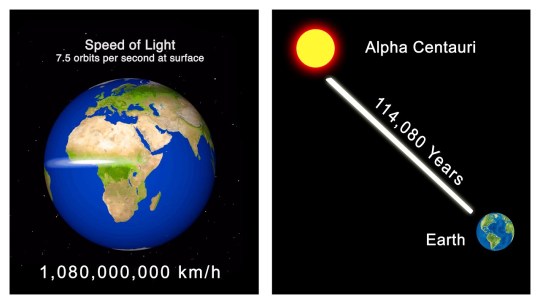
#Richard Feynman#space#astronomy#magnitude#scale#galaxy#milky way galaxy#light speed#speed of light#light year#science#religion is a mental illness
152 notes
·
View notes
Text

The Milky Way Galaxy above Stat Tso Lake
By Soumya Banerjee
The Indian Astrophotographer Of The Year 2023
#soumya banerjee#photographer#indian astrophotographer of the year#milky way galaxy#galaxy#night sky#stat tso lake#lake#landscape#nature
20 notes
·
View notes
Text
If you ever get lost in the Milky Way galaxy, this is your map to get back to EARTH.
of P.C. Budassi

#pc budassi#milky way galaxy#nasa#space#map to get back to EARTH#spiral galaxy#galaxy#earth#earth day#map#get back#complex situations#situations galaxy#unknown cosmos and unexplored space#de tot#xpuigc#xpuigc bloc
18 notes
·
View notes
Text

SPACEMAS DAY 16 ✨🪐🌎☄️☀️🌕
This featured wide-angle mosaic was taken over the steppe golden fields in Mértola, Portugal in 2020. From such a dark location, an immediately-evident breathtaking glow arched over the night sky: the central band of the Milky Way galaxy. But this sky had much more. Thin clouds crossed the sky like golden ribbons. The planet Mars appeared on the far left, while Saturn and Jupiter were also simultaneously visible. However on the opposite side of the sky, here seen on the far right. Near the top of the image the bright star Vega can be found, while the far-distant and faint Andromeda Galaxy can be seen toward the left, just below Milky Way's arch.
Image Credit & Copyright: Miguel Claro (TWAN, Dark Sky Alqueva)
#astronomy#space#science#universe#spacemas#day 16#Milky Way#galaxy#planets#mars#jupiter#Saturn#Portugal#andromeda#Milky Way galaxy#andromeda galaxy#Vega#follow#like#reblog#the first star#the first starr#thefirststar#thefirststarr#nasa#apod#tumblr#blog#space blog#solar system
111 notes
·
View notes
Text
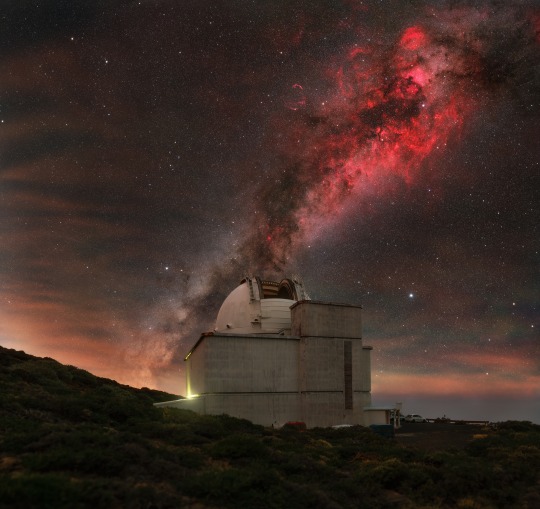
The Milky Way and its red nebulae hanging over the Isaac Newton Telescope at La Palma // Jakob Sahner
#astronomy#astrophotography#night sky#landscape#beautiful#galaxy#spiral galaxy#milky way#milky way galaxy#our galaxy#our home#la palma#canary islands#isaac newton telescope
463 notes
·
View notes
Text
2024 June 3

NGC 2403 in Camelopardalis
Image Credit & Copyright: (Team F.A.C.T.) Lilian Lbt - Cyrille Malo - Maxime Martin - Clément Daniel - Paul Grasset - Louis Leroux-Géré
Explanation: Magnificent island universe NGC 2403 stands within the boundaries of the long-necked constellation Camelopardalis. Some 10 million light-years distant and about 50,000 light-years across, the spiral galaxy also seems to have more than its fair share of giant star forming HII regions, marked by the telltale reddish glow of atomic hydrogen gas. The giant HII regions are energized by clusters of hot, massive stars that explode as bright supernovae at the end of their short and furious lives. A member of the M81 group of galaxies, NGC 2403 closely resembles a galaxy in our own local galaxy group with an abundance of star forming regions, M33, the Triangulum Galaxy. Spiky in appearance, bright stars in this portrait of NGC 2403 are in the foreground, within our own Milky Way. Also in the foreground of the deep, wide-field, telescopic image are the Milky Way's dim and dusty interstellar clouds also known as galactic cirrus or integrated flux nebulae. But faint features that seem to extend from NGC 2403 itself are likely tidal stellar streams drawn out by gravitational interactions with neighboring galaxies.
#astronaut#astronomers#not astrology#star#stars#astronomy#outer space#space#galaxy#universe#NGC#nasa#supernova#massive stars#supernova explosion#milky way#milky way galaxy#light years#years#light#earth#planets#objects in space
46 notes
·
View notes
Text
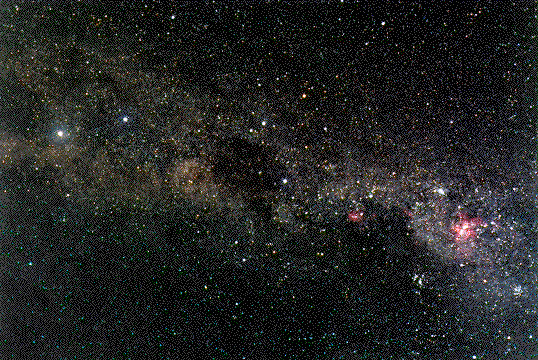
The Milky Way Near the Southern Cross - May 3rd, 1996.
"This breathtaking patch of sky would be above you, were you to stand at the south pole of the Earth. Just above and to the right of the photograph's center are the four stars that mark the boundaries of the famous Southern Cross. At the top of this constellation, also known as "The Crux," is the orange star Gamma Crucis. The band of stars, dust, and gas crossing the middle of the photograph is part of our Milky Way galaxy. In the very center of the photograph is the dark Coal Sack Nebula, and the bright nebula on the far right is the Eta Carina Nebula. The Southern Cross is so famous a constellation that it is depicted on the Australian National Flag."
#nasa#space#cosmos#universe#astronomy#astrophysics#astrophotography#milky way galaxy#southern cross#coal sack nebula#eta carina nebula
105 notes
·
View notes
Text
The Year’s Most Spectacular Photos from the James Webb Telescope
By Jeffrey Kluger
December 22, 2023

Close to 1,500 light years from Earth lie a pair of baby stellar twins known as Herbig-Haro 46/47 — which are barely a few thousand years old.
A star the size of our sun, by contrast, takes an average of 50 million years to reach even the stellar equivalent of young adulthood It's Herbig-Haro 46/47's extreme youth that gives the formation more of a blob-like appearance than the stellar duo it is.
Young stars are buried in clouds of dust and gas, which they absorb as they grow. Sometimes, however the infant stars ingest too much material too fast.
When that happens, dust and gas erupts from both sides of the formation, giving the young pair their misshapen look.
But if you have patience — 50 million years worth of patience — what is a blob today will be stars tomorrow.
NASA, ESA, CSA. Image Processing: Joseph DePasquale (STScI)
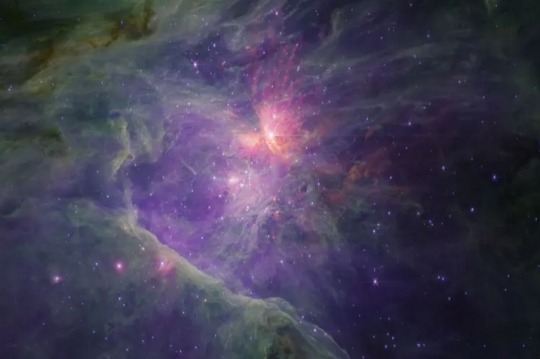
A pair of brilliant stellar nurseries located 1,600 light years from Earth, the Orion Nebula and Trapezium Cluster are home to a relative handful of very young but very bright stars.
Four of the stars are easy to see with a simple, amateur, four-inch telescope.
One of the four — the beast of the young litter — is especially visible, a full 20,000 times brighter than our sun.
Apart from their four main stars, the Orion Nebula and Trapezium cluster contain approximately 700 additional young stars at various stages of gestation.
NASA, ESA, CSA/Science leads and image processing: M. McCaughrean, S. Pearson, CC BY-SA 3.0 IGO

(L): It’s not easy being a Wolf-Rayet star, like this specimen imaged by the Webb telescope at a distance of 15,000 light years.
A rare species of stellar beast — NASA estimates there are only 220 of them in a Milky Way galaxy with at least 100 billion stars — the Wolf-Rayet burns hot and burns fast, with temperatures 20 to 40 times the surface of the sun.
All of that rapidly expended energy causes the star to lose its hydrogen envelope quickly and expose its helium core.
The result: a very early and very violent death.
A star like our sun burns for about 10 billion years. As for a Wolf-Rayet? Just a few hundred thousand before it dissolves into cosmic dust.
NASA, ESA, CSA, STScI, Webb ERO Production Team
(R): If the Wolf-Rayet star dies an ugly and violent death, the celebrated Ring Nebula, photographed by the Webb at a distance of 2,000 light years from Earth, has been expiring beautifully.
The glowing remains of a sun-like star, the nebula was discovered in 1779 by the French astronomer Antoine Darquier de Pellepoix.
As the nebula throws off its outer layers of ionized gas, it reveals its characteristic blue interior, composed of hydrogen and oxygen that have not yet been expelled off by the nebula’s stellar wind.
ESA/Webb, NASA, CSA, M. Barlow (University College London), N. Cox (ACRI-ST), R. Wesson (Cardiff University)

Dwarf galaxy NGC 6822 lives up to to its name — home to just 10 million stars, compared to the minimum of 100 billion in the Milky Way.
But what NGC 6822 lacks in numbers, it makes up in spectacle — which the keen eye of the Webb telescope has revealed.
Discovered in 1884 by American astronomer E.E Barnard, NGC 6822, is now known to have a prodigious dust tail measuring 200 light years across..
What's more, it's home to a dense flock of stars that glow 100,000 times brighter than our sun.
ESA/Webb, NASA & CSA, M. Meixnev

Spiral galaxies are often defined by uneven — and even ragged — arms.
But not galaxy M51, which lies 27 million light years from Earth and is defined by the tautness of its arms and the compactness of its structure.
M51 isn't alone in space. Nearby lies the companion galaxy NGC 5195.
The two galaxies are engaged in something of a gravitational tug of war — one that the NGC 5195 is winning.
NGC's constant gravitational pull is thought to account for both the tightly woven structure of M51's arms and for tidal forces that are thought lead to the creation of new stars in the arms.
ESA/Webb, NASA & CSA, A. Adamo (Stockholm University) and the FEAST JWST team
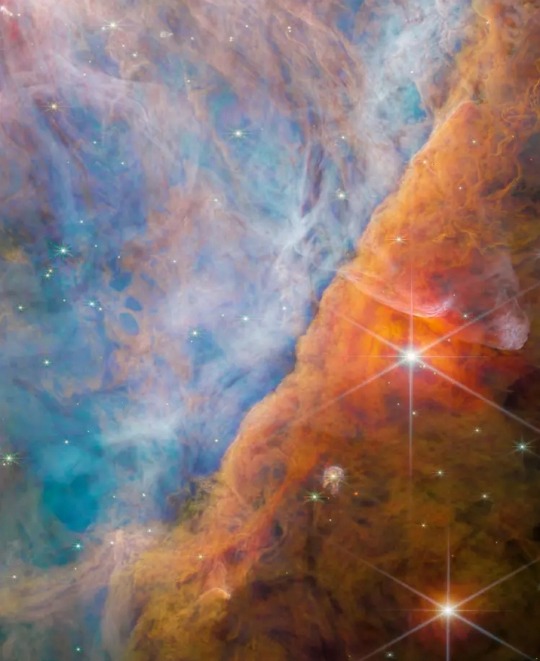
Just below Orion’s belt lies one of the most celebrated objects in the night sky: the Orion Nebula, a stellar nursery that is home to about 700 young stars.
This Webb image focuses not on the entirety of the nebula but on a structure in the lower left-hand quadrant known as the Orion Bar.
So named because of its diagonal, ridge-like appearance, the bar is shaped by the powerful radiation of the hot, young stars surrounding it.
ESA/Webb, NASA, CSA, M. Zamani (ESA/Webb), and the PDRs4All ERS Team

A baby by stellar standards, the IC 348 Star cluster is just five million years old and located about 1,000 light years from Earth.
Composed of an estimated 700 stars, IC 348 has a structure similar to wispy curtains, created by dust that reflects the light of the stars.
The conspicuous loop in the right hand side of the image is likely created by the gusting of solar winds blowing in the direction that, from Earth, would be west to east.
NASA, ESA, CSA, STScI, Kevin Luhman (PSU), Catarina Alves de Oliveira (ESA)
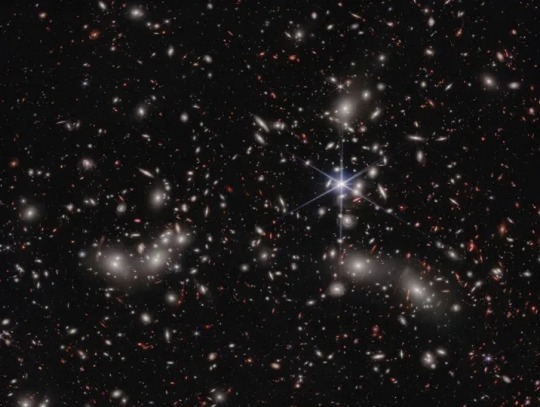
When it comes to galaxies, there's big and then there's huge and by any measure, Pandora's Cluster — more formally, known as Abell 2744 — qualifies as the latter.
Not just a galaxy, and not even a cluster of galaxies, Abell 2744 is a cluster of four clusters, which long ago collided with one another.
Located 3.5 billion light years from Earth, Pandora's Cluster measures a staggering 350 million years across.
The cluster's massive collective gravity allows astronomers to use it as a gravitational lens, bending and magnifying the light of foreground objects, making them easier to study.
NASA, ESA, CSA, I. Labbe (Swinburne University of Technology) and R. Bezanson (University of Pittsburgh). Image processing: Alyssa Pagan (STScI)

Webb was built principally to look at the oldest and most distant objects in the universe, some of 13.4 billion light years away.
But doesn't prevent the telescope from peering into its own back yard.
This image of Saturn and some of its 146 moons, rivals the images obtained by the Pioneer and Voyager probes.
NASA, ESA, CSA, STScI, Matt Tiscareno (SETI Institute), Matt Hedman (University of Idaho), Maryame El Moutamid (Cornell University), Mark Showalter (SETI Institute), Leigh Fletcher (University of Leicester), Heidi Hammel (AURA). Image processing: J. DePasquale (STScI)
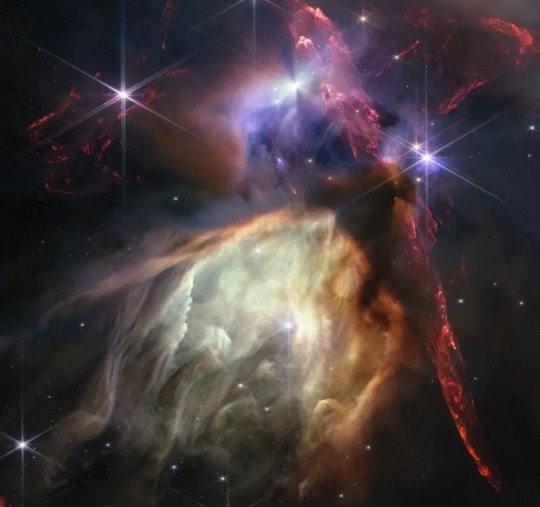
Infant stars are born all over the universe, but the closest stellar birthing suite to Earth is the Rho Ophiuchi cloud complex, located just 460 light years distant.
A turbulent — even violent — place, Rho Ophiuchi is defined by jets of gas roaring from young stars.
Most of the stars in this comparatively modest nursery are more or less the size of the sun.
But one, known as S1, is far bigger — so much so that it is self-immolating, carving a great cavity around itself with its stellar wind, the storm of charged particle's all stars emit, though few with the gale-force power of S1.
NASA, ESA, CSA, STScI, Klaus Pontoppidan (STScI)
#James Webb Telescope#James Webb Space Telescope#telescope#space#stars#galaxies#universe#cosmos#astronomy#space photography#photpgraphy#NASA#galactic clusters#milky way galaxy#Orion’s belt#Orion Nebula#Orion Bar#Pandora's Cluster#Saturn#Rho Ophiuchi cloud complex#Trapezium Cluster#Wolf-Rayet#Ring Nebula#Antoine Darquier de Pellepoix#E.E Barnard#spiral galaxy#nebula
113 notes
·
View notes
Text

source - https://twitter.com/MAstronomers
If you ever get lost in the Milky Way galaxy, this is your map to get back to EARTH.
18 notes
·
View notes